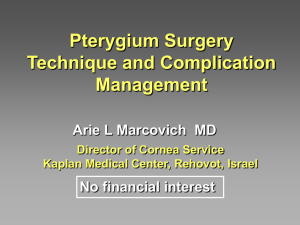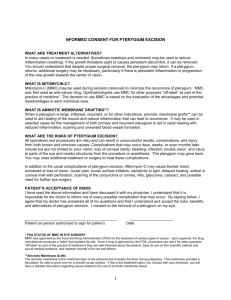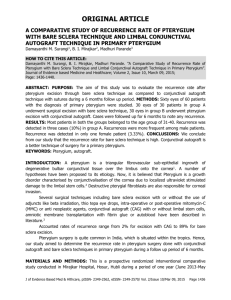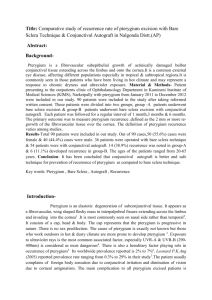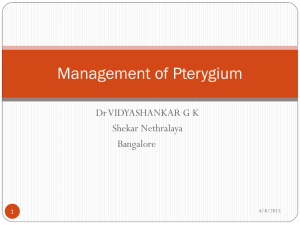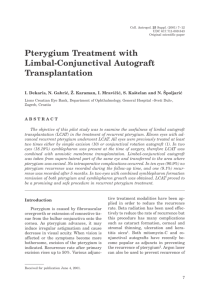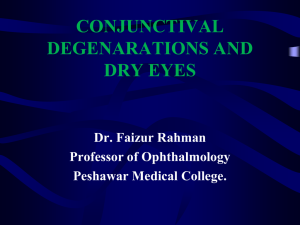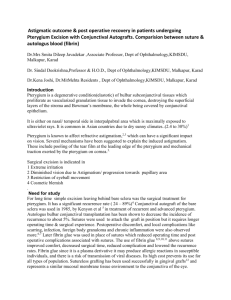DOC - Commonwealth Association for Education Administrator
advertisement
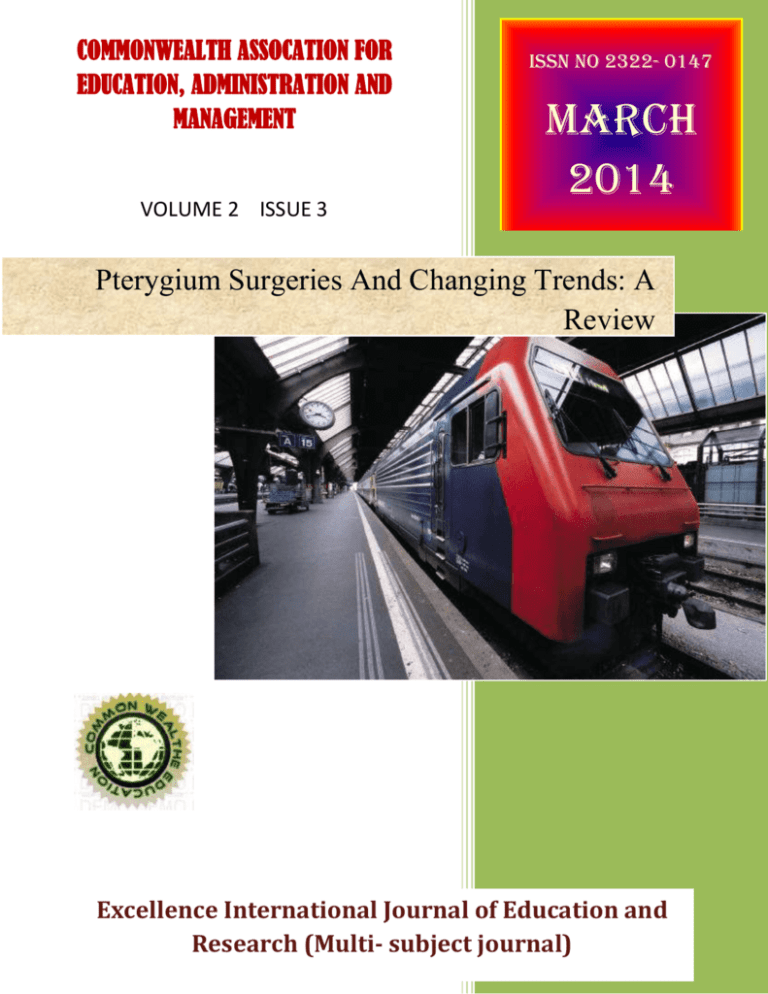
COMMONWEALTH ASSOCATION FOR EDUCATION, ADMINISTRATION AND MANAGEMENT VOLUME 2 ISSUE 3 ISSN NO 2322- 0147 MARCH 2014 Pterygium Surgeries And Changing Trends: A Review Excellence International Journal of Education and Research (Multi- subject journal) Excellence International Journal Of Education And Research VOLUME 2 ISSUE 3 ISSN 2322-0147 Pterygium Surgeries And Changing Trends: A Review By Dr. Abdul Waris MS,FICO(UK),FICS(USA) FRCS (GLASGOW),FRCSED VR Surgeon&faculty Institute of ophthalmology,AMU ALIGARH(202001) Waris_eye@yahoo.co.in Dr Naheed Akhtar Senior Ophthalmic Consultant Gandhi Eye Hosptital Ramghat Road Aligarh Uttar Pradesh Dr. Nadim Khan Resident doctor Institute of ophthalmology, AMU ALIGARH(202001) Email Id: madinkaj@gmail.com Abstract To call pterygium a perennial thorn in physicians’ sides would be an understatement. They’ve been fighting the condition for thousands of years, judging by pterygia’s appearance in Egyptian hieroglyphics. Thankfully, techniques have advanced greatly since then, and surgeons say pterygium recurrence rate is very low when the proper techniques are used.This review article, shares time-tested techniques for removing pterygia and reducing its rate of recurrence. Key Words Pterygium,Hieroglyphics, Techniques,Cornea,Conjunctiva Excellence International Journal Of Education And Research (Multi-subject journal) Page 362 Excellence International Journal Of Education And Research VOLUME 2 ISSUE 3 ISSN 2322-0147 Introduction Pterygium is a growth of fibrovascular tissue on the cornea, which appears to becontinuous with the conjunctiva.1 Prevalence rates range from 0.7% to 31% in variouspopulations around the world, and the condition is more common in warm, dry climates.2 In general, conservative therapy for pterygium iswarranted unless one of the following circumstances arises: loss of visual acuity eitherbecause of induced astigmatism or encroachment onto the visual axis, marked cosmeticdeformity, marked discomfort and irritation unrelieved by medical management, limitationof ocular motility secondary to restriction, or documented progressive growth towardthe visual axis so that ultimate loss of vision can reasonably be assumed. In such circumstances,surgical intervention is required. Because recurrences after pterygia excision arefrequent and aggressive, firm indications for surgical removal should exist before primaryexcision. The fact that numerous different techniques exist for the surgical treatment ofpterygium underscores the point that no single approach is universally successful.3 The recurrence of pterygium after surgical treatmentremains a problem. The criterion for recurrence is determined to be the invasion of cornea more than 1 mm in diameter beginning from the limbus by fibrovascular tissue derived from the surgery site.4–6 Because of the difficulty of controllingthis condition, various treatment modalities includingradiotherapy, antimetabolite or antineoplastic drugs,conjunctival flap, and conjunctival or limbal autografttransplantation have been proposed.6 Generally, pterygiumrecurrences occur during the first 6 months after the surgery.7 A number of factors such as type of pterygium, ageof patient, environment, and surgical technique may beresponsible.6 Various surgical techniques Bare sclera technique Demireller and colleagues reported 8 (42%) recurrencesin 19 eyes treated by bare sclera technique.8 Youngsondeclared the pterygium recurrence rate as 37% in 100 caseswith the same technique, and concluded that this process isunhealthy and should not be used.9This technique is not recommendedworldwide because it has no advantages other than beingsimple and time-saving. Excellence International Journal Of Education And Research (Multi-subject journal) Page 363 Excellence International Journal Of Education And Research VOLUME 2 ISSUE 3 ISSN 2322-0147 Use of mitomycin C Mitomycin C is an antibiotic isolated from Streptomyces caespitosis. It inhibits RNA, DNA, and protein synthesis andis usually used in systemic anticancer therapy. Kunitomoand Mori first described the topical use of mitomycin C toprevent pterygium recurrence in 1963 in Japan.7 Variousconcentrations of mitomycin C with different durationsof application have been used, but the minimal safe andeffective dosage and application time are still not certain.10Rubinfeld and colleagues revealed reports of scleral ulceration,necrotizing scleritis, perforation, iridocyclitis, cataract,infection, glaucoma,scleral calcification, and loss of aneye after pterygium excision with adjunctive mitomycin Ctherapy. While the exact incidence of these complicationsis unknown, the safety of mitomycin C therapy remains tobe determined with future long-term trials.11 After surgicalexcision, placing mitomycin C is a simple and time-savingmethod with a low recurrence rate. Nevertheless it has somedose-dependent complications, which can develop at anytime. Patients should be followed up for a long time. Rotational conjunctival flaps Rotational conjunctival flaps to cover the pterygiumexcisional site have been employed since the 1940s.3 Thereported recurrence rates range from less than 1% to morethan 5%. Minimal to no complications apart from flap retractionand cyst formation have been reported.12 McCoombesand colleagues recently reported a recurrence rate of 3.2%by using a sliding conjunctival flap after primary pterygiumexcision in 258 eyes with an 86% follow-up rate for aminimum of 1 year.13 The mostfrequent symptom after this procedure is the formation offolds over the conjunctiva as a result of rotated tissues in the sliding flap area. Although these folds cause bad cosmesis,including hyperemia at the begining, after a time the conjunctivaimproves and reaches an acceptable level cosmetically.Conjunctival flap tissue that is placed over bare sclera isadjacent to the excised pterygium tissue, and changed limbalcells that might be localised on the flap could contribute tothe development of recurrence. Conjunctival autograft transplantation Conjunctival autograft transplantation was first describedas a treatment for pterygium by Kenyon and colleagues in1985.14 Starc and colleagues used this method on 57 eyes of54 patients, nearly 80% of which were recurrent. The meanfollow-up of 2 years detected only three (5.3%) recurrencesafter autograft Excellence International Journal Of Education And Research (Multi-subject journal) Page 364 Excellence International Journal Of Education And Research VOLUME 2 ISSUE 3 ISSN 2322-0147 transplantation and found a 7.3% secondaryrecurrence in patients with recurrent pterygium.15 Güler andcolleagues observed all of recurrent cases (13.3%), whichwere followed up after autograft transplantation, in the under40 year age group16. These results suggest that the recurrencerate was highest in the 40–50 year age group (42.30%)in our series. There was no statistically significant differencebetween groups younger or older than 40 years. Starck andcolleagues proposed that the efficient size of the autograftdecreases the recurrence rate and this thesis is supported by Allan and colleagues.15,17 Some authors prefer lowerbulbar conjunctiva for autografting, considering that anautograft from superior bulbar conjunctiva might cause problemsin probable filtration surgery.18Syam and colleaguesreported a recurrence rate of 3.3% in a study of 27 eyes. Recurrences are found to develop within 3 months aftersurgery. Conjunctival scar ,hemorrhage under the autograft, corneal delennear the limbus, and epithelial inclusion cysts are other complications.19 Koç and colleaguesdemonstrated that autografting from superior or inferior inprimary cases caused no significant difference in recurrence,but in recurrent pterygia, autografting from inferior resultedin a higher recurrence tendency (p = 0.166).20 Complicationsresulting from conjunctival autografting are rare and are nothreat to vision. Allan and colleagues encountered one tenongranuloma, one conjunctival inclusion cyst, and threewound dehissence in a series of 93 cases, and concludedthat the conjunctival autografting technique results in lowercomplication rates.17 Vrabek and colleaguesreported subconjunctival fibrosis at the autografting region in2 cases, one of whom developed concommitant diplopia dueto extraocular muscle restriction.21 Topical corticosteroidsare suggested in order to prevent fibrosis. In most studiesof autografting, retrobulber anesthesia was performed, whichwas reported to be one of the disadvantages of this technique. The disadvantages of the conjunctivalautografting technique could be resolved as follows: along operation time, the need for retrobulber anesthesia insome cases, limitation of the autograft diameter from theconjunctiva, and can cause problems in a probable fitrationsurgery. One of the other disadvantages of suturing ispostoperative pricking. This effect might be minimized byplacing the knot under the conjunctiva or using continuoussuturing. In spite of all these difficulties, the recurrence rateis lower with this technique. After the operation, a smooth,white surface is achieved cosmetically. The disadvantageof the long operation time becomes an advantage with alow recurrence rate and no need for additional surgicalintervention. As these are the most desired aims of surgery,the conjunctival autografting technique therefore deservesclear recognition. Excellence International Journal Of Education And Research (Multi-subject journal) Page 365 Excellence International Journal Of Education And Research VOLUME 2 ISSUE 3 ISSN 2322-0147 Amniotic Membrane Grafts Moreover, for those withadvanced pterygia with wide conjunctival involvement ormultiple heads, conjunctival autografts might be limited bythe lack of remaining healthy tissue in the same or fellow eye. For these reasons, an alternative tissue source has beensought. Many authors have reported that amniotic membranegrafts are a viable alternative to conjunctival autograftsin reducing recurrences after pterygium excision. Thepossible mechanisms of preventing pterygium recurrenceinclude promotion of conjunctival epithelium, inhibition ofinflammation by inhibiting chemokine expression by fibroblasts22-32and interleukin-1 expression by epithelial cells, andinhibition of neovascularisation by inhibiting vascularendothelial cell growth.The amniotic membrane is known to contain a thickbasement membrane and a vascular streamed matrix.The basement membrane facilitates migration ofepithelial cells, reinforces adhesion of basal epithelial cells, promotesepithelial differentiationand prevents epithelial apoptosis.33,34Collectively, these actions explain why the amnioticmembrane permits rapid epithelialisation. Although amniotic membrane graftsare less proficient than conjunctival autografts in reducingrecurrences after pterygium excision, it indicates that thistechnique could be considered as an alternative in thesurgical management of pterygia, especially when the baresclera technique alone has an unacceptably high recurrence,35and complications related to mitomicin-C as an adjunctivetreatment are a concern. Summary In conclusion, even in treating primary pterygium, additional methodsshould be used. When possible complications and morbidityare taken into account in the selection of this additionalmethod, Conjunctival autograft should be considered as the first choice for pterygium excision even if there is a recurrence. The amniotic membrane graft can also be considered to be the first choice for those with advanced and diffuse conjunctival involvement (bi-head) or those who might like to preserve the donor bulbar conjunctiva for a prospective glaucoma-filtering procedure. Excellence International Journal Of Education And Research (Multi-subject journal) Page 366 Excellence International Journal Of Education And Research VOLUME 2 ISSUE 3 ISSN 2322-0147 Disclosure The authors report no conflicts of interest. References 1. Taylor HR, West S, Munoz B, et al. The long-term effects of visiblelight on the eye. Arch Ophthalmol. 1992;110:99–104. 2. Tasman W, Jaeger EA. Duane’s Clinical Ophthalmology. Philadelphia,PA: Lippincott Williams and Wilkins;2002;6:35. 3. Krachmer JH, Mannis MJ, Holland EJ, et al. Cornea. Philadelphia:Mosby;1998:1. 4. Al Fayez MF. Limbal versus conjunctival autograft transplantation foradvanced and recurrent pterygium. Ophthalmology. 2002;109:1752–5. 5. Donnenfeld ED, Perry HD, Fromer S, et al. Subconjunctival mitomycinC as adjunctive therapy before pterygium excision. Ophthalmology.2003;110:1012–16. 6. Mutlu FM, Sobaci G, Tatar T, et al. A Comparative Study of RecurrentPterygium Surgery. Ophthalmology. 1999;106:817–21. 7. Adamis AP, Starck T, Kenyon KR. The management of pterygium.Ophthalmol Clin North Am. 1990;3:611–23. 8. Demireller T, Durak İ, Gürsel E, et al. [Primer ve rekürren pterjiumtedavisinde Mitomycin C.] Oftalmoloji. 1992;4:329–31. 9. Youngson RM. Recurrence of pterygium after excision. Br J Ophthalmol.1972;56:120–5. 10. Lam DS, Wong AK, Fan DS, et al. Intraoperative Mitomycin C toprevent recurrence of pterygium after excision: a 30-month follow-upstudy. Ophthalmology. 1998;105:901–4. 11. Rubinfeld RS, Pfi ster RR, Stein RM, et al. Serious complicationsof topical mitomycin-C after pterygium surgery. Ophthalmology.1992;99:1647–54. 12. Hirst LW. The treatment of pterygium. Surv Ophthalmol.2003;48:145–80. 13. McCoombes JA, Hirst LW, Isbell GP. Sliding conjunctival fl ap for thetreatment of primary pterygium. Ophthalmology. 1994;101:169–73. 14. Kenyon KR, Wagoner MD, Hettinger ME. Conjunctival autografttransplantation for advanced and recurrent pterygium. Ophthalmology. 1985;92:1461–70. 15. Starck T, Kenyon KR, Serrano F. Conjunctival autograft for primaryand recurrent pterygia: surgical technique and problem management.Cornea. 1991;10:196–202. 16. Güler M, Sobacı G, İlker S. Limbal-conjunctival autograft transplantationin cases with recurrent pterygium. Acta Ophthalmol. 1994;72:721–6. 17. Allan BD, Short P, Crawford GJ, et al. Pterygium excision with conjunctivalautografting: an effective and safe technique. Br J Ophthalmol.1993;77:698–701. 18. Broadway DC, Grierson I, Hitchings RA. Local effects of previousconjunctival incisional surgery and the subsequent outcome of fi ltrationsurgery. Am J Ophthalmol. 1998;125:805–18. 19. Syam PP, Eleftheriadis H, Liu CSC. Inferior conjunctival autograft forprimary pterygia. Ophthalmology. 2003;110:806–10. 20. Koç F, Demirbay P, Teke MY, et al. [Primer ve rekürren pterjiumda konjonktival otogreftleme.] T Oft Gaz. 2002;32:583–8. 21. Vrabec MP, Weisenthal RW, Elsing SH. Subconjunctival fi brosis afterconjunctival autograft. Cornea. 1993;12:181–3. Excellence International Journal Of Education And Research (Multi-subject journal) Page 367 Excellence International Journal Of Education And Research VOLUME 2 ISSUE 3 ISSN 2322-0147 22. Bultmann S, You L, Spandau U, et al. Amniotic membrane down-regulateschemokine expression in human keratocytes. Invest Ophthalmol Vis Sci1999;40:S578. 23. Tseng SCG, Li DG, Ma X. Suppression of transforming growth factor-betaisoforms, TGF-B receptor type II, and myofibroblast differentiation in culturedhuman corneal and limbal fibroblast by amniotic membrane matrix. J CellPhysiol 1999;179:325–35. 24. Kobayashi A, Inana G, Meller D, et al. Differential gene expression by humancultured umbilical vein endothelial cells on amniotic membrane. Presented atthe 4th Ocular Surface and Tear Conference; 14 May 1999, Miami, FL, USA. 25. Kim JC, Tseng SC. Transplantation of preserved human amniotic membranefor surface reconstruction in severely damaged rabbit corneas. Cornea1995;14:473–84. 26. Vastine DW, Stewart WB, Schwab IR. Reconstruction of the periocular mucousmembrane by autologous conjunctival transplantation. Ophthalmology1982;89:1072–81. 27. Camara JG, dela Cruz-Rosas B, Nguyen LT. The use of a radiofrequency unitfor harvesting conjunctival autografts in pterygium surgery. Am J Ophthalmol2004;138:165–7. 28. Hilgers JHC. Pterygium: incidence, heredity and etiology. Am J Ophthalmol1960;50:635–44. 29. Mackenzie FD, Hirst LW, Battistutta D, et al. Risk analysis in the developmentof pterygia. Ophthalmology 1992;99:1056–61. 30. Tananuvat N, Martin T. The results of amniotic membrane transplantation forprimary pterygium compared with conjunctival autograft. Cornea2004;23:458–63. 31. Liotta LA, Lee CW, Morakis DJ. New method for preparing large surfaces ofintact human basement membrane for tumor invasion studies. Cancer Lett1980;11:141–52. 32. Campbell S, Allen TD, Moser BB, et al. The translaminal fibrils of the humanamnion basement membrane. J Cell Sci 1989;94:307–18. 33. Boudreau N, Sympson CJ, Werb Z, et al. Suppression of ICE and apoptosis inmammary epithelial cells by extracellular matrix. Science 1995;267:891–3. 34. Boudreau N, Werb Z, Bissell MJ. Suppression of apoptosis by basementmembrane requires three-dimensional tissue organization and withdrawalfrom the cell cycle. Proc Natl Acad Sci USA 1996;93:3500–13. 35. Fernandes M, Sangwan VS, Bansal AK, et al. Outcome of pterygium surgery:analysis over 14 years. Eye 2005;19:1182–90. Excellence International Journal Of Education And Research (Multi-subject journal) Page 368
